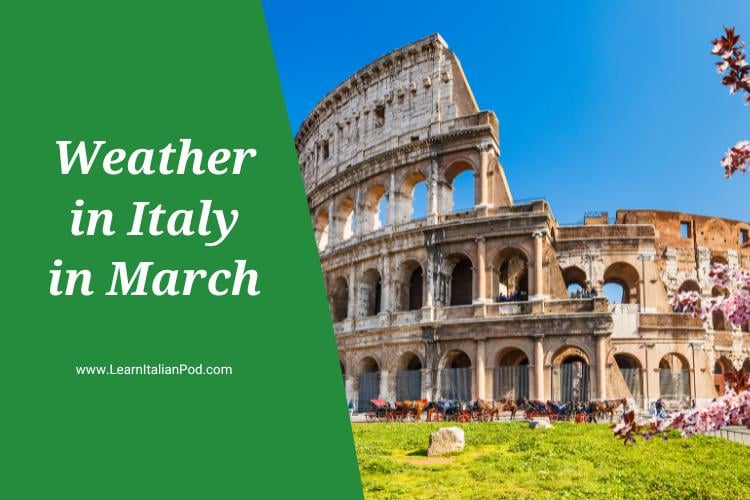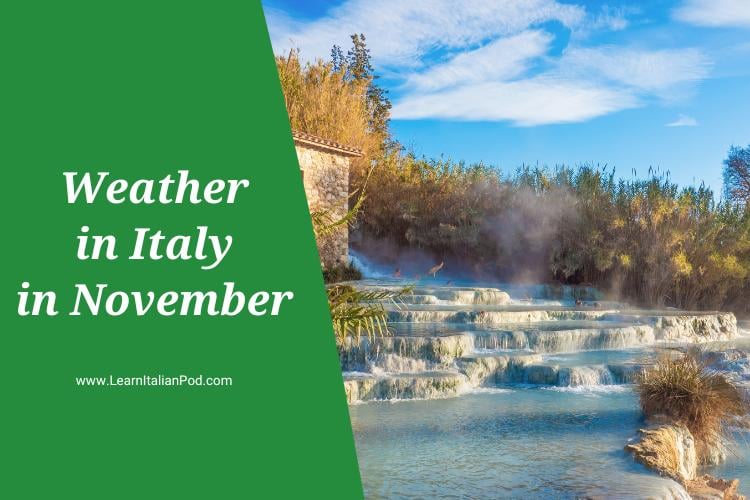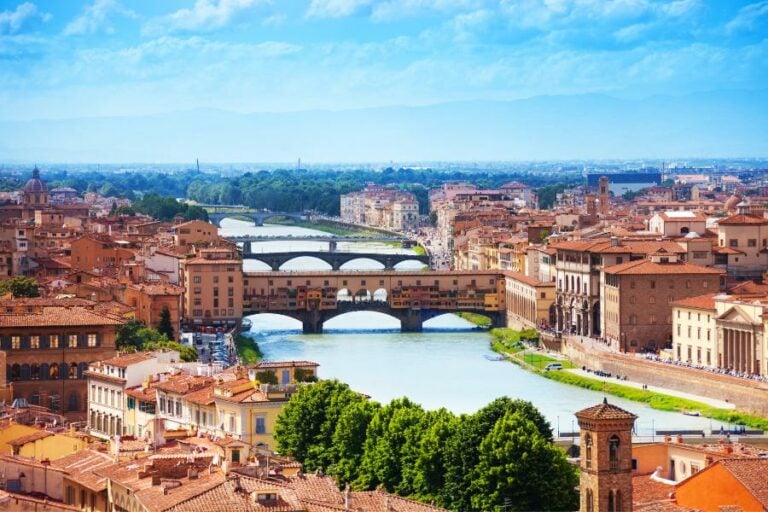Weather in Italy in March: Your Essential Travel Guide
Planning your trip to Italy in March? This comprehensive guide has everything you need to know about the weather in Italy in March.
We’ve integrated weather patterns, appropriate attire, must-visit places, and unique experiences specific to March in Italy.
Leveraging robust research, personal insights, and visitor feedback, our guide ensures reliable and accurate travel expectations for your journey.
Weather in Italy in March: What to Expect

March in Italy is a beautiful time of year, as it marks the beginning of spring. The weather starts to warm up, but it’s not too hot, making it a great time to explore the country’s stunning landscapes and historic cities.
In the northern regions like Milan and Venice, temperatures can range from 40°F to 60°F. It can still be quite chilly, especially in the evenings, so it’s a good idea to pack a warm jacket. You might also experience some rain, as March can be a bit unpredictable.
The weather is milder in central Italy, including cities like Rome and Florence. Expect temperatures to be between 50°F and 65°F. You’ll have plenty of sunny days, but there can still be occasional rain showers. So, don’t forget to pack a light raincoat or umbrella.
Down south, in regions like Sicily and Sardinia, the weather starts to feel more like summer. Temperatures can reach up to 70°F during the day, making it perfect for enjoying the beautiful beaches or exploring the countryside.
Average Temperatures in Italy in March
| Location | High | Low | Avg. Rainy Days |
|---|---|---|---|
| Northern Italy | 59°F / 15°C | 41°F / 5°C | 8 rainy days |
| Central Italy | 65°F / 18°C | 50°F / 10°C | 7 rainy days |
| Southern Italy | 68°F / 20°C | 52°F / 11°C | 8 rainy days |
| City | High | Low | Avg. Rainy Days |
|---|---|---|---|
| Milan | 57°F / 14°C | 38°F / 3°C | 6 rainy days |
| Venice | 59°F / 15°C | 41°F / 5°C | 6 rainy days |
| Florence | 59°F / 15°C | 42°F / 5.5°C | 10 rainy days |
| Rome | 57°F / 14°C | 41°F / 5°C | 8 rainy days |
| Naples | 64°F / 17°C | 50°F / 10°C | 7 rainy days |
| Palermo | 68°F / 20°C | 52°F / 11°C | 8 rainy days |
Overall, March is a fantastic time to visit Italy. The weather is comfortable, the spring flowers are blooming, and the summer crowds haven’t arrived yet. Just remember to pack layers and be prepared for a few rainy days.
Gearing up for a trip to Italy and need language help? Check out our essential Italian phrases for travel, including a convenient PDF cheat sheet.
Should You Visit Italy in March?

Are you considering a trip to Italy in March? This section will provide valuable insights to help you make that decision.
Reasons to Visit Italy in March
Visiting Italy in March can be a fantastic idea for several reasons. One of the most significant advantages is the fewer crowds. As March is considered an off-peak season, you’ll find fewer tourists, which means you can explore the country’s iconic landmarks at your own pace.
This is particularly beneficial when visiting archaeological sites like Pompeii, Herculaneum, and Agrigento. These sites are less crowded and cooler in March than in the summer, making your visit more enjoyable and comfortable.
Another advantage of visiting Italy in March is the end of the ski season. If you’re a fan of winter sports, this is the perfect time to hit the slopes. The weather is still cold enough for skiing but not as harsh as the peak winter months.
In addition to these, March is a great time to save money on your Italian vacation. Hotels and activities generally cost less during this time of year, so you can stay in better accommodations or participate in more activities without breaking the bank.
Lastly, visiting Italy in March allows you to experience the country’s beautiful spring landscapes. As the country transitions from winter to spring, you’ll witness nature’s rebirth, with flowers blooming and trees regaining their leaves.
With fewer tourists, you’ll get to experience ‘real life’ in Italian cities and towns. This is a unique opportunity to immerse yourself in the local culture and truly understand what makes Italy so special.
Reasons Not to Visit Italy in March
Visiting Italy in March may not be the best idea if you’re looking to enjoy the country’s famous sunny skies and outdoor activities.
The weather is unpredictable at this time of year, often grey and rainy, which can dampen your plans to explore the beautiful Italian countryside or relax on the beach.
Speaking of beaches, don’t expect to take a dip in the sea during March. The water is still too cold for swimming, and many beach clubs and businesses in smaller villages are closed for the season.
If you’re a fan of shopping, March might also disappoint you. By this time, the winter sales are over, so you won’t be able to snag those great deals you might find in the colder months.
In short, if you’re looking for the full Italian experience – sunny weather, warm beaches, bustling local businesses, and a variety of outdoor activities – you might want to reconsider visiting in March.
Can’t decide when to visit Italy? Explore our essential weather-centric monthly travel guides.
- Weather in Italy in January
- Weather in Italy in February
- Weather in Italy in March
- Weather in Italy in April
- Weather in Italy in May
- Weather in Italy in June
- Weather in Italy in July
- Weather in Italy in August
- Weather in Italy in September
- Weather in Italy in October
- Weather in Italy in November
- Weather in Italy in December
What to Wear in Italy in March
When planning a trip to Italy in March, it’s important to consider the weather so you can pack the right clothes. March is a transition month in Italy, marking the end of winter and the beginning of spring. The weather can be quite unpredictable, with temperatures ranging from cool to mild.
In northern Italy, including cities like Milan and Venice, the weather can still be quite chilly in March, with temperatures ranging from 40°F to 60°F. Therefore, it’s advisable to pack warm clothing like sweaters, long-sleeve shirts, and a medium-weight jacket. A waterproof coat or umbrella is also a good idea, as occasional rain showers can occur.
The weather is milder in central Italy, including Rome and Florence, with temperatures ranging from 50°F to 65°F. You might still need a jacket or sweater for the cooler mornings and evenings, but you can often get by with lighter clothing like long-sleeve shirts and jeans during the day.
In southern Italy and Sicily, the weather starts to warm up in March, with temperatures often reaching up to 70°F. Lighter clothing is generally sufficient, but bringing a jacket or sweater for cooler days or evenings is still a good idea.
Regardless of where you’re going in Italy, comfortable walking shoes are a must, as you’ll likely be doing a lot of walking. Also, Italians are known for their fashion sense, so you might want to pack some stylish outfits if you plan on dining out or visiting upscale areas.
Where to Go and What to Do in Italy in March

Experience the charm of Italy in March with our five top recommendations for places to visit and activities to do that take full advantage of this time of year.
1. Sightseeing in Rome
March is an ideal time to visit Rome as the weather is mild and the city is less crowded. Explore the Colosseum, Roman Forum, and Vatican City, and enjoy the city’s rich history and culture.
2. Wine Tasting in Tuscany
Tuscany is famous for its vineyards and wine. In March, the weather is perfect for a wine tour, where you can taste some of the world’s best wines and enjoy the beautiful Tuscan countryside.
3. Skiing and Hiking in the Dolomites
For outdoor enthusiasts who enjoy both winter sports and hiking, the Dolomites are a must-visit in March. The skiing conditions remain favorable, and the breathtaking mountain landscapes provide excellent hiking trails.
4. Exploring the Canals of Venice
Venice is less crowded in March, making it a great time to explore the city’s famous canals by gondola. The weather is cool but comfortable, perfect for sightseeing.
5. Hiking in Cinque Terre
March is the start of the hiking season in Cinque Terre. The weather is cool, and the trails are less crowded, offering a peaceful and scenic hiking experience.
Planning the perfect trip to Italy? Check out the definitive guide to the 35 best travel guide books for Italy.
Holidays and Closures in Italy in March
While Italy has no national holidays or closures in March, it is worth noting that Easter sometimes falls in March. If it does, it’s a major holiday with many businesses and attractions closing.
Easter is a significant religious holiday in Italy, marked by church services, processions, and feasts. If Easter falls in March, it can affect visitors as many shops, restaurants, and tourist attractions may be closed.
Festivals and Events in Italy in March
Eager to dive into the vibrant events and festivals in Italy in March? We’ve got you covered with five major happenings to look forward to during this time.
1. Festa della Donna (International Women’s Day)
Celebrated on March 8th, Festa della Donna is a significant event in Italy that honors women’s achievements and promotes gender equality. On this day, yellow mimosa flowers are customary gifts to women, symbolizing respect and appreciation.
2. Festa di San Giuseppe / Father’s Day
This religious festival, also known as Father’s Day in Italy, is celebrated on March 19th. It pays homage to St. Joseph, the patron saint of fathers, workers, and the Catholic Church.
Festivities encompass processions and feasts, along with crafting ornate altars adorned with traditional Sicilian pastries known as “zeppole.”
3. Holy Week and Easter (sometimes in late March)
Occasionally landing in late March, Easter marks the climax of Holy Week, Italy’s second most significant religious observance after Christmas.
This period is marked by deep devotion and a range of events such as masses, processions, and papal ceremonies, primarily centered in Vatican City, Rome – the heart of Catholicism.
Given the influx of visitors during this period, early flight and hotel reservations are advised if you intend to be in Rome.
4. Mandorlo in Fiore (Almonds in Bloom)
Mandorlo in Fiore, a delightful spring celebration, revels in the allure of almonds amidst the picturesque UNESCO sites in Sicily, particularly in the Agrigento region.
This March event, translating to “almonds in bloom,” marries gastronomic adventures with vibrant artistic and cultural presentations.
5. Festa di San Patrizio (St. Patrick’s Day)
Although not originally an Italian festival, St. Patrick’s Day has gained popularity in many cities across Italy, particularly in Rome and Milan. This Irish holiday is celebrated on March 17th, with parades, live music performances, and iconic green-colored decorations.
These events in Italy during March offer diverse cultural, religious, and festive experiences, attracting both locals and tourists alike.
Suggested Reading: 21 Famous Italian Symbols & Meanings: Icons of Italy
Weather in Italy in March FAQ

Have any lingering questions about the weather conditions in Italy during March? This section should address your queries.
Is March a Good Time to Visit Italy?
Yes, March is a good time to visit Italy. It is considered off-peak season, so fewer tourists make it easier to explore landmarks at your own pace. The weather is still cold enough for winter sports like skiing but not as harsh as the peak winter months.
Additionally, hotel and activity costs are generally lower. Lastly, you can experience the country’s beautiful spring landscapes and immerse yourself in the local culture.
Is Italy Crowded in March?
No, March is not typically crowded in Italy. This is considered the low season, so visitors can enjoy museums and city streets without large crowds. However, be aware that indoor activities may be busier on rainy days.
How Much Does it Rain in Italy in March?
Rainfall in Italy in March can vary, but it generally ranges between 0.51 inches (13mm) to 1.18 inches (30mm).
Is it Humid in Italy in March?
No, Italy does not experience high humidity in March. The weather can vary, but it is usually transitioning from winter to spring with moderate rainfall.
What Should I Wear in Italy in March?
When traveling to Italy in March, prepare for various weather conditions.
It can be chilly in the north, like Milan and Venice (35°F-55°F), so pack warm clothes and a raincoat.
Central Italy, including Rome and Florence, is milder (40°F-60°F), so bring a mix of light and medium-weight clothing.
Southern Italy and Sicily are warmer, often up to 65°F, so lighter attire is suitable, but include a jacket for cooler times.
Comfortable shoes are essential for walking, and stylish outfits are recommended for dining out or visiting high-end areas.
Final Thoughts
Whether you’re an adventure seeker or a foodie, Italy in March has something for everyone. Keep in mind that the weather information is based on historical data, so it’s always a good idea to check the forecast closer to your trip. Enjoy Italy!







